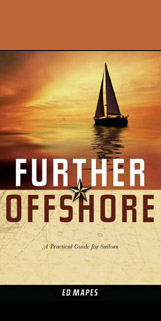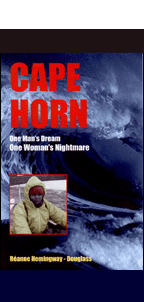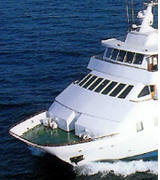|

“The parachute—in heavy
weather sailing”
By
Casanova
appearing in the 1976 issue of
Multihulls.
The theory on parachute sea anchoring during severe gales mentioned in
books and magazines draws a horrible picture of the boat being pulled
through the giant waves. I have proved this theory wrong but if it were
so, it would be better to go through the top four or five feet of wave
than upside down.
In 1966 I was sailing my Piver 30’ Nimble trimaran down the coast,
Seattle to San Francisco, with my three sons as crew. It was just after
dark, the wind increased and the seas became quite angry and rough. Our
position was 15 miles west of the infamous Cape Mendecino. My first
gale!
Reading all the books to prepare me for
this situation didn’t stop me from shaking with fear and concern for our
safety. I had to come up with something fast. I fought the jib down and
off the forestay while my little Nimble was being thrown about. I had
read in one of Piver’s books about a Lodestar 35’ surviving a cyclone in
the Pacific by hanging to a parachute sea anchor, so I was prepared with
a parachute and a 150 foot shock cord. I promptly set out the chute
although I had no information on how to go about doing it. The Nimble
spun around quickly into the weather and at this point ship and crew
became quite comfortable.
Here was survival. Little did I know that there was a lot to learn.
Anyone “just throwing” a parachute out and hoping it will work, soon
learns there is more to it. I spent hours retrieving fouled chutes. Hand
many time, became raw from rope burns. Untold dollars were spent on
breakage and loss of equipment. One fact that couldn’t be overlooked—we
came through each storm safely and a little more knowledgeable.
Tortuga, our Ed Horstman designed Tri-Star Trimaran, in which we logged
over 33,000 blue-water miles, was tethered from a parachute sea anchor
many times. Two recorded cyclones and severe Indian Ocean gales are
included in these survival times. Winds recorded off New Zealand’s
coast, in one storm, were 85 to 90 miles per hour. Seas in the Indian
Ocean reached an estimated forty feet during one heavy blow. The weather
was so bad crossing the Indian Ocean that one out of six days was spent
tethered from our 28 foot sea anchor. This midwinter nonstop crossing
taught us a lot.
I credit the parachute sea anchor for saving Tortuga, my wife Joan, and
myself from death during a wild Kona storm in the Hawaiian Islands in
1971. Crossing the channel between Molokai and Oahu we reefed the main
to handkerchief size and put up our 80 foot storm sail; still, Tortuga
bombed along at a good 10 knots. We continued toward Diamond Head whose
cone shape could be seen on the horizon. The radio reported favorable
weather reports. “Beautiful trade winds,” they said. Actually the winds
shifted, blowing Kona—from the opposite direction. Unfamiliar with this
condition we sailed on believing it was the regular channel wind
conditions. Increasing winds caused an undetermined amount of leeway.
Tortuga caught in the curve between Diamond Head and Coco Head could not
beat her way out. We had no engine and no room to maneuver. We dropped
sails and the 28-foot chute was released off the bows. The winds reached
65 knots at this time. Six hours passed with leeward drift causing the
reef with its curler waves and white water to close in on the boat. The
wind howled to 80 miles an hour accompanied by pelting rain and
darkness. Tortuga drifted backward at the same time taking several waves
over the deck. These waves built up to a point at which a boat could
sail over them. If we hadn’t had a parachute off the bows to hold us
into the sea we would have gone upside down, not through them. I had a
knife in my hand ready to cut the tether but something told me, if I do
so, I’m dead. After the next curler rolled over the deck and boat
lurched backward safely, I knew we would be safe. We were lifted by the
big waves over the reef into calmer water inside. The chute held,
slowing the downwind movement toward shore until it caught on coral and
ripped to pieces. By now Tortuga stopped her mad race and lay aground
until morning. Inspection revealed no hull damage, other than scratches.
The only other damage that could be seen was the four inches ground off
the rudder. The use of the chute in this condition was the extreme.
Crossing the Coral Sea, (in July, the wrong month) Tortuga beat to
windward, inching away the miles. We lost 93 miles drifting in one gale
because I didn’t use the parachute sea anchor. This was the mileage
gained from three days of beating. The parachute will keep your boat
from drifting and loosing many miles.
Sea anchors have been used as far back as the Polynesians. Hove to in
South Pacific gales they used sea anchors made of stone. Holes were
drilled through to which hau fiber and three strand hibiscus line was
tied. These anchor were tethered from the bows of the giant outrigger
canoes. Charles Borden’s book “Sea Quest” gives an excellent account of
this.
William G. Van Dorn talks about sea anchoring in his book “Oceanography
and Seamanship”: “If the reader wonders why I have devoted so much space
to storm anchoring it is simply my conviction that this technique could
save many a boat that might otherwise be lost. Even one saved would be
well worth the effort.”
I believe many upside down Trimaran accidents could have been prevented
if they had properly used the parachute sea anchor. Sad to say, cruising
people will fight storms until exhausted, to save crew and ship when all
they had to do was set out the chute, be comfortable and safe.
Exhausted, many sailors have made the wrong decision putting the ship in
danger. You can cook a hot meal, rest and read. Your mind clear. Why
fight it?
Boats of all sizes and description have used the sea anchor
successfully. However, the correct formula is important. The accepted
theory is diameter of parachute equals, at least, the beam of the boat.
I carried two parachutes, both Air Force Surplus 28-foot- a little
larger than my 20-foot beam.
Since the parachute is attached by harness to the ama bows, larger
cleats bolted through the deck are necessary.
The following is my set-up procedure for parachute sea anchoring. Most
items you already have aboard. All you may have to buy is the sea
anchor. Harness lines could be your mooring lines. The tether line, your
anchor line. Shackles, swivels and fenders may already be included in
your boat’s inventory.
Harness
The harness to first swivel is approximately one and a half times boat
length. (Tortuga’s 35 foot length required 50 feet to first swivel). All
lines must be thimbled to shackles and swivels to avoid chafe. Since
they are attached to swivels by shackles, all
shackles must be safe tied. (We lost one shackle because it
was not safe tied). The ends of harness are cleated to outrigger bows to
whatever length I feel the boat is riding the easiest. Since the wave
length determines the length of the harness, too short a harness makes
the boat motion jerky as the boat corrects quickly. The longer the line,
the longer the boat takes to recover.
Swivels are required to keep the line from twisting and destroying
itself. You will need two swivels, one at each end of the tether. I used
half-inch size.
Tether
The tether is 10 times length of the boat.
(Tortuga’s tether was 350 feet, again with thimbles each end to join
swivels). The line can be your anchor line. I carried 9/16 nylon because
it DOES give and stretch.
Parachute
The parachute should be the open cone design and have the shrouds
attached. The open cone gives a cushioning effect to the boat. Two
chutes carried will provide one as spare.
Trip line
The trip line is attached to the parachute cone and a boat fender is
attached to the same line 25 to 40 feet from the cone, keeping the chute
from submerging deeper than the fender. (I used 3/8 nylon). The end of
the line is cleated to either ama bow. This line was my light anchor
line, a full spool, 600 feet.
How to use your chute
My routine after leaving port and out of sight of land, begins by
attaching harness to swivel, to tether. Bring all lines on port side,
making sure that the starboard line of the harness is out in front and
around the forestay. Lines must clear
everything on deck to make the descent into the sea (if not,
it will clear the deck for you!). I handle the parachute the same way
one handles an anchor. The harness line in the cockpit first, then start
feeding the tether line on top until you come to parachute, the first item put into the sea. In a
separate pile beside the chute is the trip line. Both lines are free to
go out, including fender. The parachute is kept tied into a neat bundle
so it can not come apart unless you untie it.
Now for the procedure.
When conditions are such that I feel it is
time to use the chute (normally under storm sail) take all sail down first. I lash my
tiller straight (backward movement may destroy the rudder): I untie the
parachute and hold it under my arm, protecting it from the wind, and
make my way to the port bow. I throw over the fender and start easing
the parachute, cone first, into the sea. As the chute is fed into the
water (it is not difficult, even though it is the weather side) I hold
the lines taut for a moment, helping the chute to open (it opens very
quickly) then the tether and trip line will start moving off the deck
smoothly. I continue to help lines from fouling or catching on deck
hardware. The boat will immediately turn into the weather and seas. Once
all is set and the boat is under pressure, tighten trip line almost to tripping point. Make sure
this line is taut otherwise you will never separate the lines after the
storm.
Never wait until the last minute to put out the chute. Watch your bad
weather signs. When you become nervous and a bit concerned it is time to
use the parachute and – go below, relax, if you can!

Click
here to learn more about
Multihulls
Magazine.
|
















